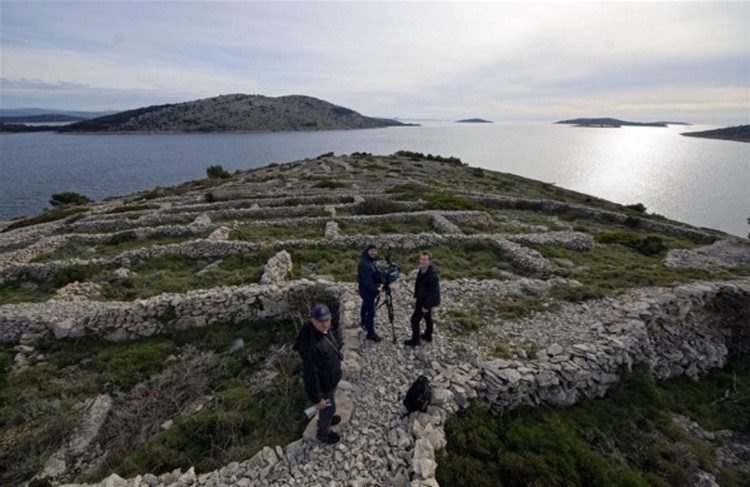From above, the island looks like a giant fingerprint with its lively vertical and horizontal lines.
The small island being referred to is called Baljenac or Bavljenac. Baljenac is a “member” of the Sibenik archipelago in the Adriatic Sea, off the beautiful coast of Croatia. With an area of approximately 1.4 km2, Baljenac has an irregular oval shape, with its surface covered in numerous dry stone walls. Thus, when viewed from an airplane, one cannot help but be amazed by this small island’s stunning landscape, resembling a giant fingerprint with its vividly patterned lines.

From above, the island looks like a giant fingerprint with its lively vertical and horizontal lines.
Regarding the “lines” made of stone on the island, they can be explained in detail by historical records.
Like many other Western European countries such as Ireland, England, or Scotland, in most rural and coastal areas of Croatia, local residents have built low stone walls to “assert their ownership” and mark the boundaries of neighboring farmland.


These are stone walls built by Croatian farmers.
While it is called building, in reality, due to a lack of resources to buy cement for mortar, they devised a way to stack stones on top of each other to create a fairly solid structure. This method has been applied for a very long time in history, resulting in the remnants we see today.
When discussing this method, many might think that Croatian farmers are shortsighted; however, on the contrary, this is an incredibly smart approach that maximizes arable land. This idea stems from Croatia’s natural conditions.


This small island’s stunning landscape resembles a giant fingerprint with its vividly patterned lines.
Most coastal areas of this country are characterized by limestone terrain, so farmers have limited agricultural land. “Necessity is the mother of invention”, to overcome this challenge, local farmers figured out how to separate the stones from the land, and to minimize the labor involved in transporting these stones, they came up with the idea of using them to “build walls”. This is an example of a two-fold solution.

The total length of these stone walls reaches up to 23 km.
This uninhabited island has an area of 0.14 km² but boasts 23 meters of walls created by stacking stones. This simple construction method is also used on the islands of Kaprije and Zut. However, Bavljenac remains the island with the highest density of stone walls per surface area.
Most of the stone wall network is believed to have been built in the 19th century. Historically, both Bavljenac and Kaprije served as safe havens for Christians during the Ottoman conquests in the 16th and 17th centuries. Therefore, some parts of these walls may have been constructed during that time.
Currently, the Croatian government is striving to have UNESCO recognize Baljenac and its intricate stone walls as a World Cultural Heritage site.
In 2018, Bavljenac was included in UNESCO’s list of intangible cultural heritage.
According to the tourism management board, the walls are witnesses to a period of hard work and perseverance, serving as the key to conquering the harsh yet beautiful limestone landscapes along the Adriatic coast.
Bavljenac is a sun-drenched island dotted with vineyards and fragrant groves of fruits such as figs and citrus. Today, the island is considered a testament to the cultural wealth and tranquility of the Mediterranean.
Visitors to Bavljenac can participate in a boat tour around the island. However, they cannot dock on the island as there is no port.
The nearest center to Bavljenac is Sibenik, a historic city in central Dalmatia; Bavljenac is one of the 249 islands in the Sibenik archipelago.


















































